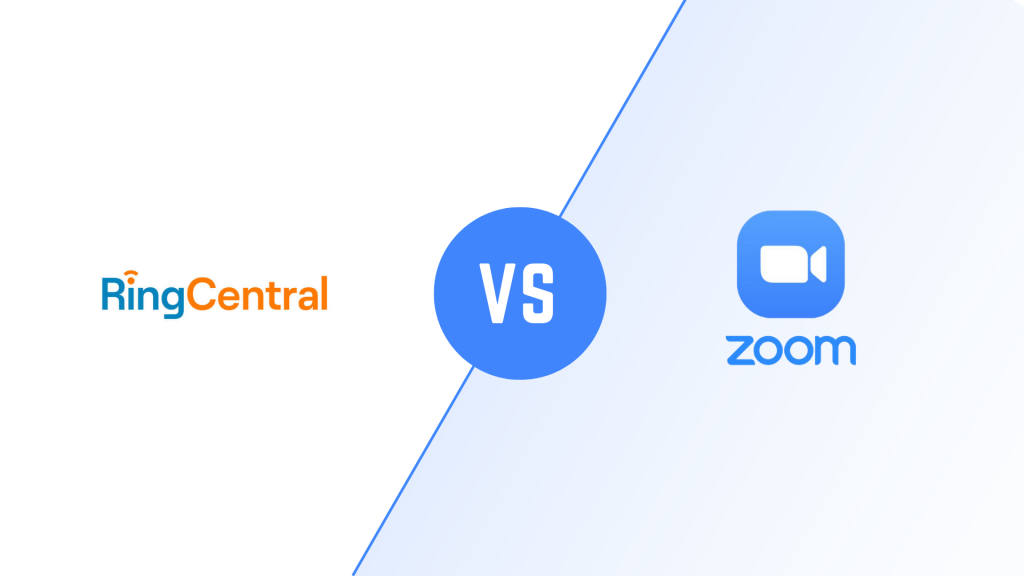Two prominent business communication platforms are Zoom and RingCentral. Because both firms offer phone and video conferencing, studying how they provide and price their services will help you decide which platform is ideal.
Read on to find out if Zoom or RingCentral is better for you as a small business owner, consultant, or solopreneur.
Scheduling and Recording Meetings: RingCentral vs. Zoom
One of the most important aspects of any business video call software is the ability to schedule and record virtual meetings. Meetings can be prepared directly from the Zoom and RingCentral applications and Outlook and Google calendar interfaces.
The commercial versions of both platforms allow you to schedule meetings for yourself and others. On the other hand, RingCentral stands out thanks to its well-designed native calendar interface, which lets you color-code appointments and create events for specific teams.
Zoom’s free version allows you to do so when recording meetings as they happen, but the recordings must be saved locally on your device. You can also store the recording in the cloud if you upgrade to a premium plan. RingCentral allows you to store recordings in the cloud; your plan level depends on the amount you can hold.
Both platforms allow you to send the tape to participants after the meeting. You may also send out meeting highlights and snippets via RingCentral, so folks don’t have to listen to the entire recording. On the other hand, RingCentral does not record meeting communications, although Zoom does.
Zoom also includes built-in automatic audio transcripts, eliminating the need to take notes during a conference. Transcription is only available on RingCentral through a third-party program interface.
RingCentral vs. Zoom: Security
Zoom has garnered headlines during the epidemic for its enormous development and its ongoing security challenges—so persistent that the term “Zoom bombing” has entered the modern lexicon. Even though most of these security holes have been fixed, Zoom’s security reputation is still not very good, and new holes have been found in recent months.
While Zoom is suitable for regular chats—especially if you password-protect the meeting and enable two-factor authentication on your account—RingCentral might be a better choice if you work in a high-security business. While both Zoom and RingCentral provide end-to-end encryption, RingCentral has less public history of data breaches and a more curated user base, making it less attractive for hackers.
RingCentral vs. Zoom: Overview
1. RingCentral
As a top VoIP service provider, RingCentral’s MVP product offers various capabilities to benefit any organization. It is a perfect alternative to consider if you need a business phone number with additional services. In addition to toll-free and business phone lines, RingCentral provides account users with team messaging, voicemail-to-text services, and document sharing. Video meetings with up to 200 participants are also available in the higher-priced tiers.
RingCentral does not offer a free VoIP service, but it does offer RingCentral Video Pro, which offers free video conferencing for up to 100 people.
Key Features
- RingCentral’s video solutions allow you to invite up to 200 people to a video conference.
- Excellent Clarity: Enjoy full HD audio and video with excellent clarity.
- Comprehensive Security: Meetings are password-protected to prevent unauthorized access.
- Ease of Use: The meeting setup is simple and easy.
- Coverage Around the World: More than 80 countries worldwide are represented.
Pros
- Free video meetings and team communications are available.
- Account holders get a toll-free number and a business phone number.
- Calls within the United States and Canada are unlimited.
- The higher tiers provide more options. Customer service is available. 24 hours a day, seven days
Cons
- Customer service is tardy in responding.
- Occasionally, calls are dropped.
- The software might be more user-friendly.
2. Zoom
Unsurprisingly, Zoom topped our ranking of the best video conferencing platforms. The free plan, which allows you to hold video conferencing conversations for up to 40 minutes, is a terrific way to try out the service. Customers will likely be familiar with the platform as one of the top players in the video conferencing industry, reducing technical issues before and during meetings. If you upgrade to a subscription plan, you can host meetings for up to 100 people for up to 30 hours.
Zoom Phone is a separate service that costs $10 per month per user and gives you a US or Canadian phone number and the ability to make and receive calls from different devices.
Key Features
- Audio and video calls are available all around the world.
- Detailed Analytics: Reports and post-meeting analytics that show vital information.
- Several Integrations: Slack and Gmail, for example, are easily integrated.
- Recording Features: Screen capture and session recording are both available.
- Exceptional clarity: audio and video reception are crystal clear.
Pros
- The free edition has many features, such as hosting up to 100 people.
- Screen-sharing software
- design that is simple to use and understand.
- extensive Integrations
- For the premium version, social media streaming is available.
Cons
- Group meetings are limited to 40 minutes in the free tier.
- Participant’s inability to delete nasty comments The mobile app has limited features.
People also asked
What is RingCentral used for?
RingCentral is primarily a VoIP service provider and is often regarded as a market leader. Account holders can connect with clients and customers via phone calls, text messages, and video conferencing using the company’s cloud-based communication services. For a complete experience, you can also use video services and connect to other software.
Is Zoom free to use?
A free version of Zoom allows you to host endless meetings with up to 100 people for up to 40 minutes and unlimited one-on-one conferences for up to half an hour. That may be plenty for some people and businesses, but paid options start at $14.99 monthly for those eager to upgrade—or avoid being thrown off the platform after 40 minutes.
Is there a free version of RingCentral?
Not in the case of the VoIP service. RingCentral charges a monthly subscription fee that starts at $19.99. RingCentral Video is a different service the company offers. It lets you do video conferencing and team messaging for free and without limits.
Conclusion
Both Zoom and RingCentral are outstanding commercial communication systems. While both allow you to use a VoIP phone line for your business and host video conferencing, Zoom specializes in video conferencing, while RingCentral is primarily a VoIP service provider.
Zoom is a terrific alternative if you want to host video meetings and want your clients to be able to connect from their desktop or mobile devices. Customers will be more familiar with the software and can traverse it more readily due to the company’s fame and reputation. On the other hand, RingCentral is a better option if you only require a business phone number.





